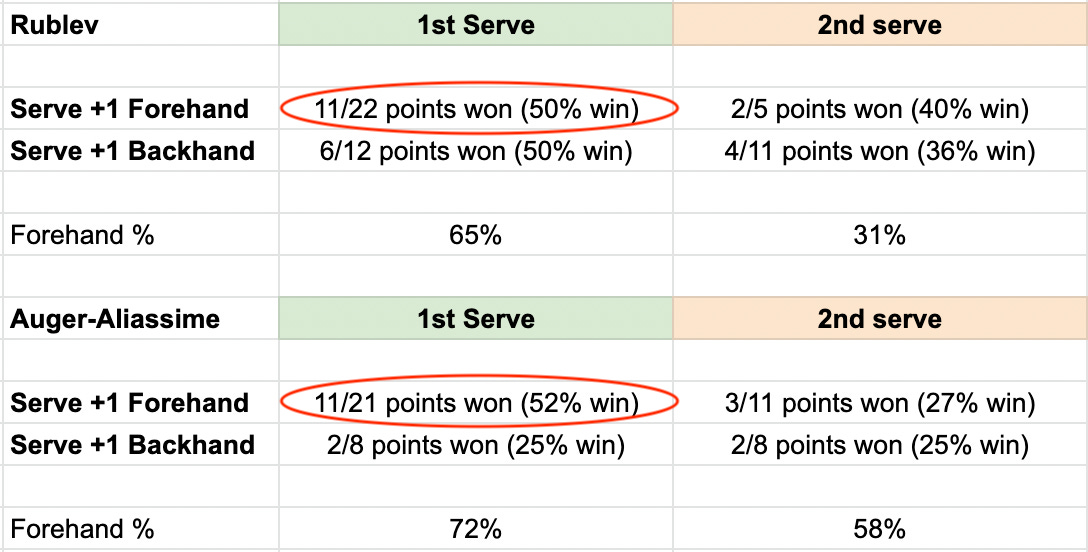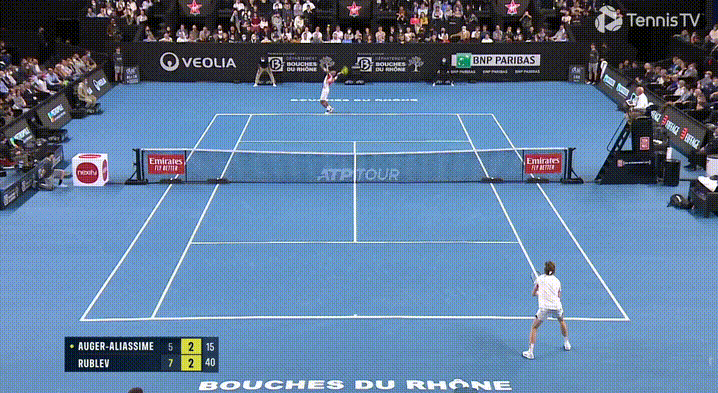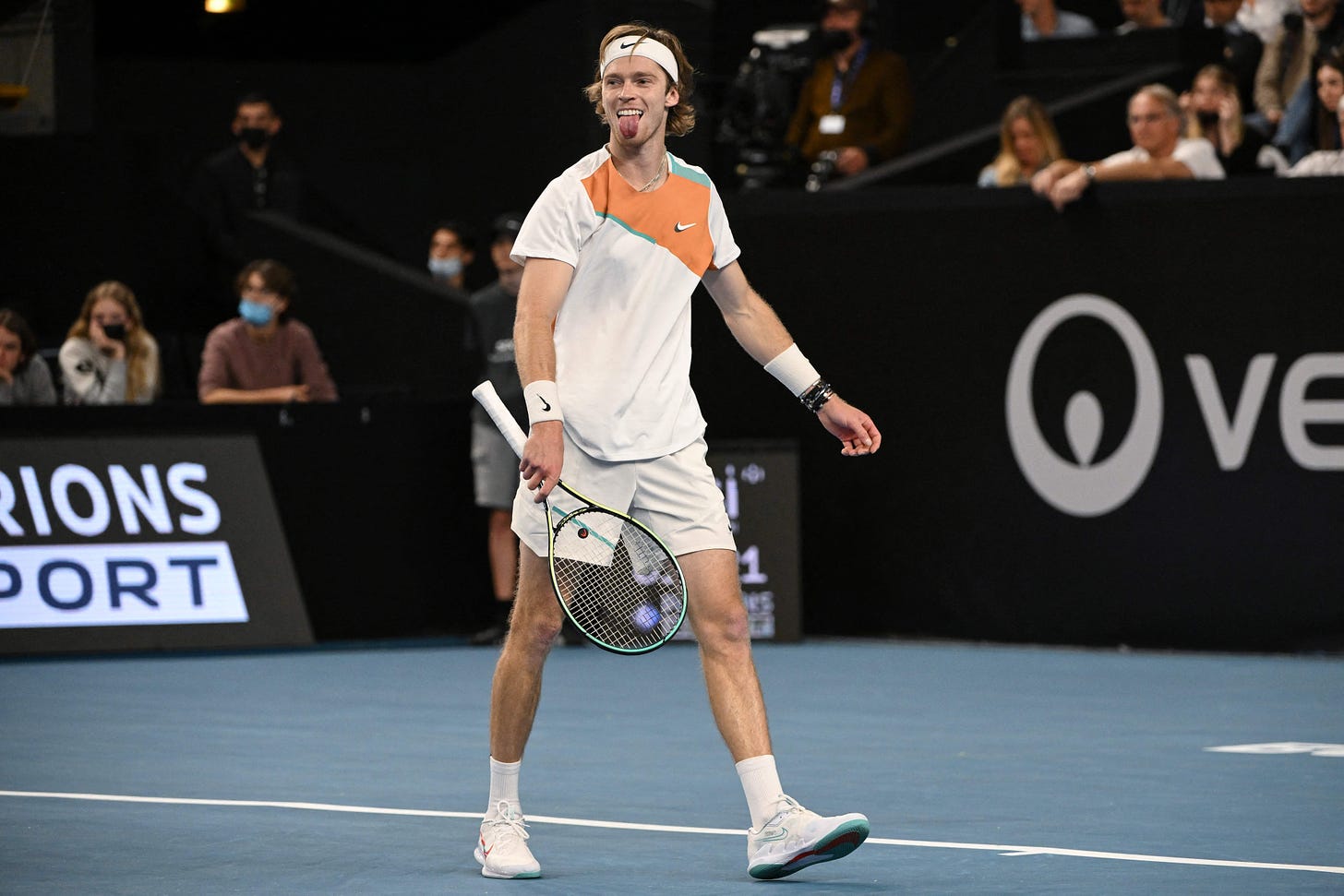Rublev's Less Flashy Shot
Rublev's return and backhand foils Auger-Aliassime: rally strategy, serve+1's, 2nd serves
Rublev d Auger-Aliassime: 7-5, 7-6(4)
An up and down match. Neither guy played their best that consistently (although Rublev was the better player), and apart from Auger-Aliassime catching fire after going down a break in set two, the Canadian looked pretty jaded after his title run last week in Rotterdam. The footwork, explosive forehands, and consistent backhands of last week, and much of 2022 so far, really weren’t there for the most part for Auger-Aliassime. But Rublev did do a bunch of stuff really well to compound his opponent’s problems. This is one of those unusual results between two top players where it’s not really a bad loss for the loser, and a pretty significant win for the winner (Rublev hasn’t had the best start to the season until now).
One of the nice things about Auger-Aliassime having just played a final in Rotterdam last week against another elite player, is that you can compare and contrast some matchup keys between the two matches.
Serve and +1
Both struggled pretty often on serve (Auger-Aliassime faced 11 break points, Rublev 5) with neither player really looking that comfortable on their first few shots. A mixture of unusual errors on short balls and good returning meant that both guys only won about 50% of the points when landing a 1st serve and getting to play a forehand as their second (serve+1) shot. This is abnormally low for both:

But Rublev did a better job than Auger-Aliassime today, outside of those usual 1st serve and forehand strengths that nearly all modern players lean on.
Two things were true:
Auger-Aliassime didn’t hit either groundstroke as well as he can. His forehands after his serve didn’t quite have the same depth and power of his title run last week, which is part of why his forehand % is higher than Rublev despite losing more points (FAA hitting 72% forehands after 1st serves and 58% forehands after 2nd serve compared to Rublev’s 65% and 31%).
Rublev, both on return and once he had worked his way into rallies, did things that Tsitsipas found hard to do last week, which made some of Auger-Aliassime’s preferred short point construction and rally patterns more difficult.
Camping out in the backlands
Last week Auger-Aliassime thoroughly won the battle from his own backhand corner against Tsitsipas. He could afford to camp in that backhand corner and hit forehands (or trade backhands), knowing that it would be hard for Tsitsipas to go down the line with his single handed backhand into the open space. Today however, Rublev’s steadier and less leaky backhand did a hell of a lot of good work at keeping Auger-Aliassime less comfortable in that position. This didn’t really manifest much until the 5-5 game in set 1, but thereafter it was a significant factor.
Last week Auger-Aliassime could afford to do this:

Against Rublev today however, and especially in the 5-5 game that proved to be the decisive break in set one, Auger-Aliassime didn’t enjoy the same dynamic:



Auger-Aliassime can certainly play a better game than that one at 5-5. But once in the rally Rublev was able to do things from his own backhand corner that Tsitsipas couldn’t against Auger-Aliassime last week in Rotterdam. Not only did Rublev’s cross court backhand hold up better defensively, allowing Auger-Aliassime fewer opportunities to hit offensive forehands from that backhand corner, but it was also an offensive weapon down the line.
This continued into set 2:


Rublev winning the backhand corner battle was a feature in nearly every single important point of the match:

2nd serves
Rublev’s biggest weakness is his 2nd serve. And while I do think he did quite well at times today to keep that underpowered 2nd serve away from Auger-Aliassime’s forehand return by hitting a loopy kick serves like the one in the GIF above (on set point), Auger-Aliassime was also a bit generous in important moments:


Neither guy won a lot of 2nd serve points in set one. But Rublev managed to win 10/16 (63%) of his 2nd serve points in set two (Auger Aliassime won just 5/16 or 31%). That is unusually high for Rublev against a Top 10 opponent. Even with his low % in set 1, Rublev finished the match against Auger-Aliassime with his highest 2nd serve win rate against a Top 10 player in the last 12 months (his 12 month average vs Top 10 is 36%, today it was 50%, and 63% in set 2). And while Rublev was doing plenty of things right in rallies as noted further up, Auger-Aliassime will be disappointed not to have done more on those soft serves in order to try and set up some of the kind of successful early point aggression we’ve seen from him recently.
A fine loss and a great win
This was an entertaining final mostly because it gave a really good comparative window into how different matchups at the very top of the game can be right now, and how those matchups can affect player strengths and weaknesses.
On the back of probably too much recent tennis, Auger-Aliassime’s level wasn’t quite there today, regardless of what was happening at Rublev’s side of the court. But Rublev’ superior backhand and superior return of serve, relative to Tsitsipas, created a bunch of scenarios which were very different to the ones Auger-Aliassime faced in last Sunday’s final. Auger-Aliassime will be disappointed with his forehand potency and backhand shot tolerance today, which happen to be two things that have been brilliant for the start of the season. But Rublev should also get significant credit for kickstarting his season with such a solid backhand performance. Rublev’s forehand always gets the credit, but it was often his all round play from his own backhand corner, both in terms of backhands cross court and down the line, and inside in forehands, which won him the match and the title.
A perfectly fine loss for Auger-Aliassime after his maiden title last week, and a really good win for Rublev.
— MW
Twitter: @mattracquet
See you on Thursday.
Top: Rico Brouwer/Soccrates/Getty, Bottom: NICOLAS TUCAT/AFP via Getty
Most recent:





